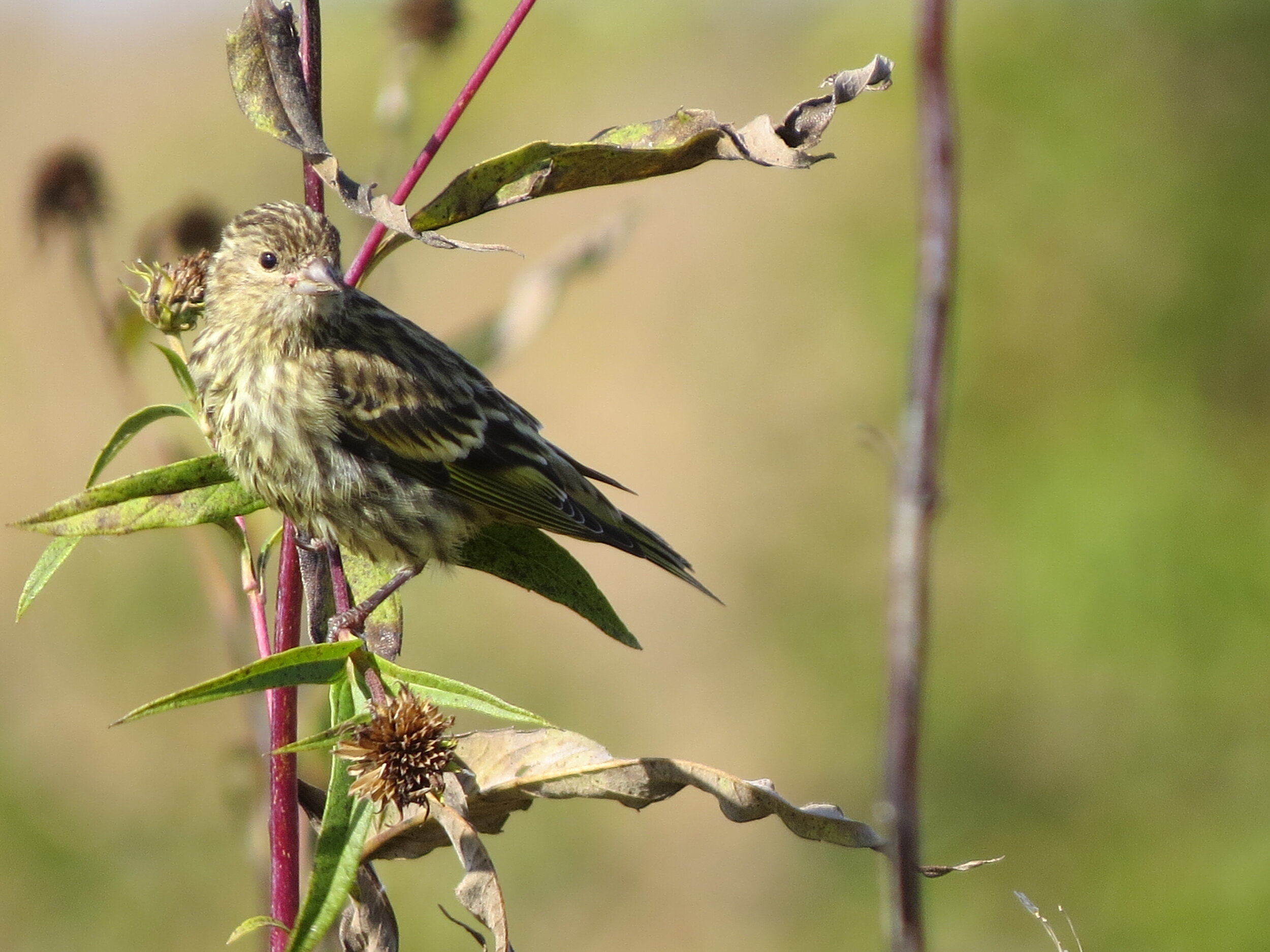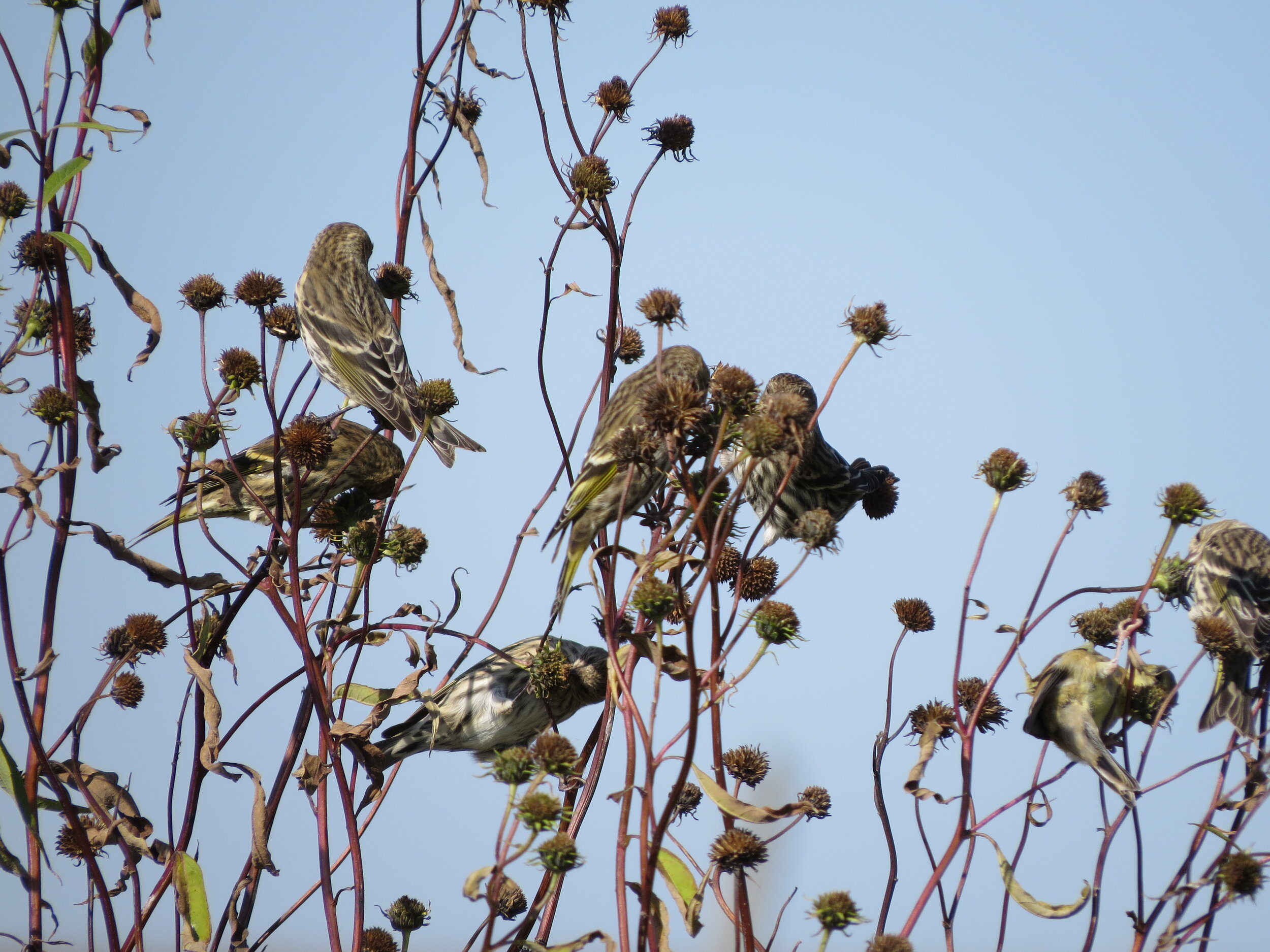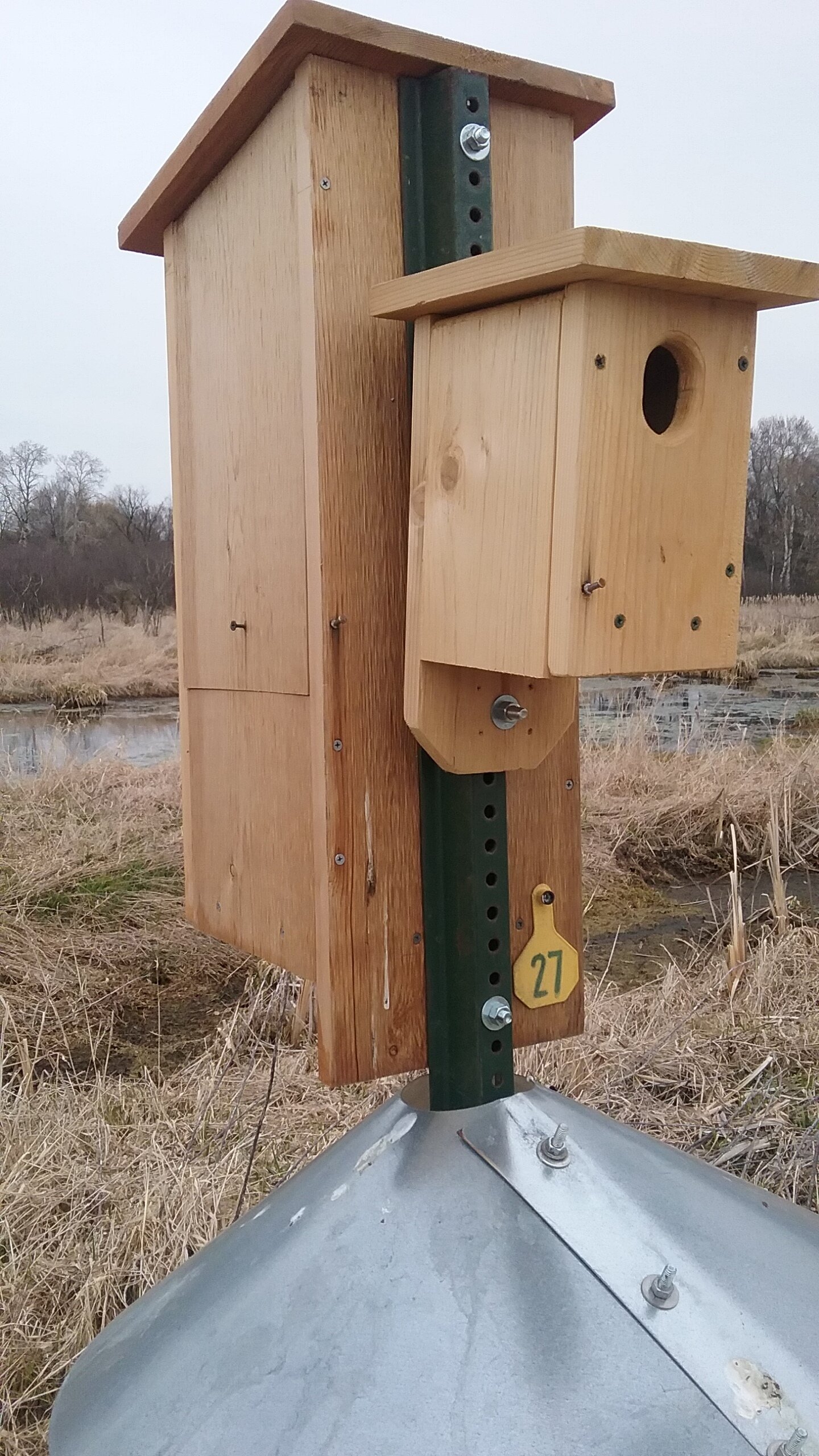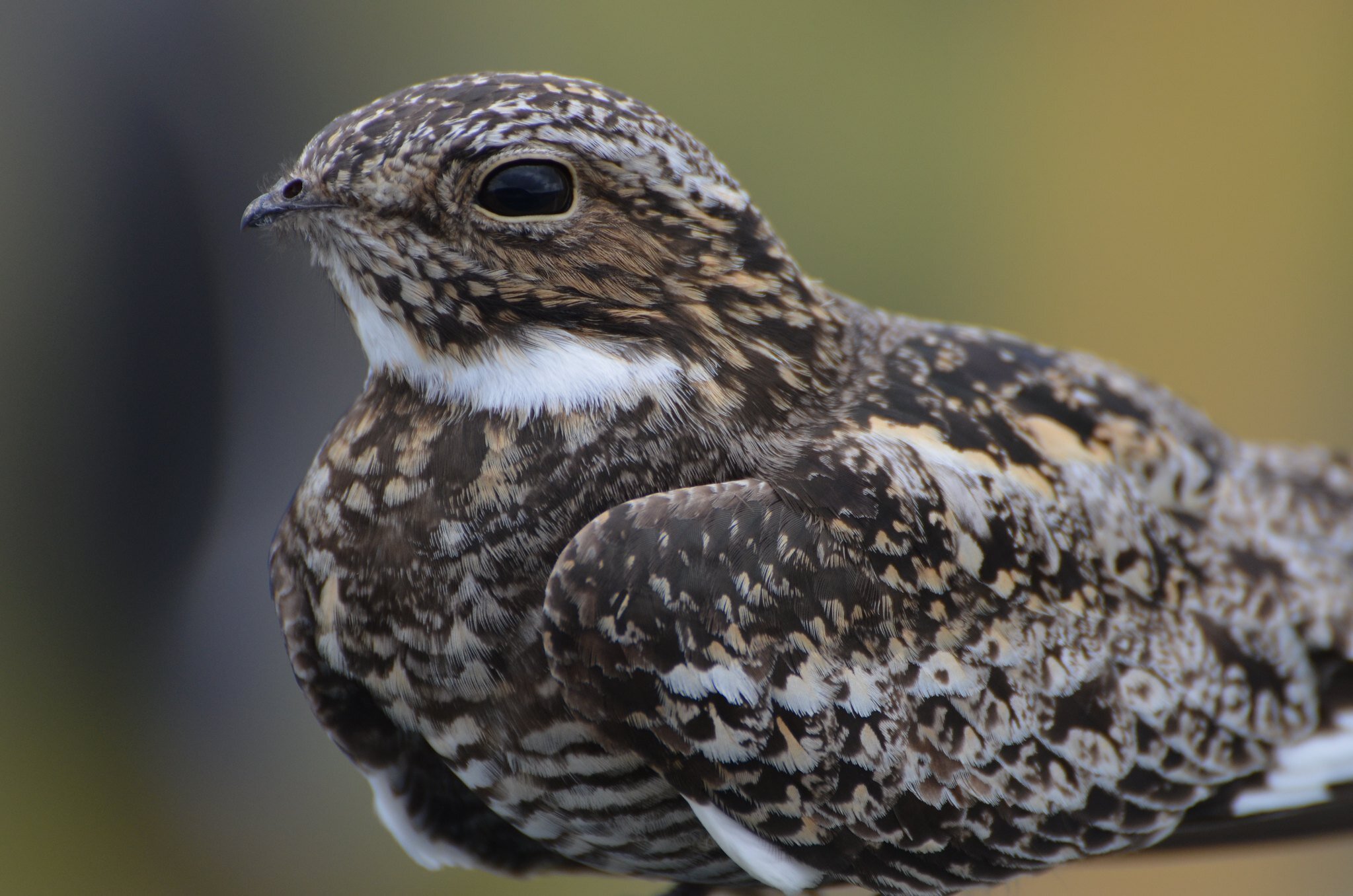Pine siskin on sawtooth sunflower, photo by Mark Martin
The Winter Finch Forecast 2020-2021, released in September by Tyler Hoar with the Ontario Field Ornithologists, incorporates data from many volunteers on seed production in the boreal forest and provides a forecast on finch numbers and movement across Canada and the northern United States.
Tyler wrote “PINE SISKIN: Large numbers of siskins are currently being reported in areas with excellent spruce crops in the western boreal forest. The siskins likely will remain concentrated in Western Canada with its heavy spruce cone crops for the winter. The small numbers remaining in the eastern boreal forest should move southward looking for food. At feeders they prefer nyger seeds in silo feeders.”
Ryan Brady from Wisconsin DNR shared, “The southbound parade of Pine Siskins has already subsided here in the north where numbers are few compared to a month ago. The wave has expanded throughout the U.S. to and beyond our southern border with Mexico. Here's an interesting read about them being forced into nocturnal migration, which is atypical for finches: https://finchnetwork.org/irruption-alert-astonishing-pine-siskin-nocturnal-migration”
Hawk Ridge Bird Observatory at Duluth counted almost 11,000 siskin migrating south by October 13th. Many bird watchers in Wisconsin are reporting many pine siskins also this fall.
Large numbers of pine siskins were reported at Goose Pond beginning on October 5th when Aaron Holschbach reported 60 pine siskins: “Large flock of siskins in weedy fields on the north end of the pond. Impressive numbers of Pine Siskins have moved south this fall.” Also on the 5th Tom Anderson reported 80 siskins. This was a new high count of siskins for Goose Pond Sanctuary.
Pine siskin flock, photo by Tom Anderson
On October 6th Jim Otto reported 200 siskins saying, “the number of individuals is an estimate, which is likely low; there were possibly many more present feeding on the seeds of sawtooth sunflowers.” This was a new record high count for Goose Pond and Columbia County.
Pine siskin photo by Jim Otto
Goose Pond seed collectors have been seeing large numbers of siskins and we organized a pine siskin count on October 8th. Due to the COVID-19 Virus our count was different than most counts in that the five of us (Graham Steinhauer; Tanner Pettit, 2020 intern; Tucker Sanborn, 2020 summer intern and fall seed collector; Jim Otto, Goose Pond volunteer, and Mark) divided up into four teams and searched upland prairies that especially contained good numbers of sawtooth sunflowers. At the end we combined our data into one count.
We found an impressive number of 1,017 siskins and probably missed a few hundred since we did not search all prairies. The checklist provides more information on our count.
Tanner Pettit also found a Nelson’s sparrow at Sue Ames prairie that is rare at Goose Pond. Other sparrow watchers found more Nelson’s sparrows and at least one LeConte’s sparrow south of the Browne Prairie bench in Jill’s Prairie west of the water in the food plot and prairie. On October 10th Mike McDowell reported 12 Nelson’s and one LeConte’s sparrows
Pine siskins feasting on sawtooth sunflowers, photo by Jim Otto
Tanner Pettit wrote “I was excited to get out and bird for a couple hours because I was seeing many large flocks of birds flying around while collecting seeds, but I never got a good look at them. It turns out they were Pine Siskins! A bird I’ve only witnessed once before. My first location to check was Sue Ames Prairie. There are a lot of sawtooth sunflowers in this prairie and that is where I saw these flocks congregating earlier in the week, presumably to eat the abundant ripe sunflower seeds. Needless to say, I had high hopes for this location. Upon arrival I took the first right onto the trail that loops around the outside border of the prairie. Immediately I saw the flocks I was looking for. I quickly identified a pine siskin eating the seeds of the sawtooth sunflower. The streaking breasts helped give it away. I slowly drove closer and the birds were not that afraid. However, they would repeatedly fly from where they were feeding up into the wind row of trees when suddenly flushed. This allowed me to get an accurate estimate. I used my phone to take a video and slow it down to estimate a flock of about 100 birds. I observed for about 30 minutes and estimated the flock to be about 350 birds! It was truly an extraordinary sight to see. It feels good to help provide habitat to an array of species and be able to witness them enjoy their stay at Goose Pond Sanctuary.”
Sawtooth sunflowers in bloom at Goose Pond Sanctuary earlier this summer, photo by Madison Audubon
Sam Robbins wrote in 1991 Wisconsin Birdlife “The most spectacular flight ever recorded for the unpredictable Pine Siskin in Wisconsin occurred on 21 October 1969, when Dan Berger estimated that over 50,000 small finches passed by the Cedar Grove Ornithological Station in Sheboygan County. There were some Common Redpolls, American Goldfinches, and Purple Finches among them, but most of the birds were Pine Siskins.”
In years of major irruption, some pine siskins remain in southern Wisconsin and begin nesting in April. In the recently completed 2015 - 2019 Breeding Bird Atlas II there were reports of pine siskins nesting in southern Wisconsin in 2018 including many observations from Madison.
The Cornell Laboratory of Ornithology provides the following information on Pine Siskins. “Irruptive Pine Siskins' winter movements are erratic and depend partly on the state of cone crops in northern North America. About every other year, Pine Siskins irrupt, or move into central and even southern parts of the continent, but the timing and extent of these movements are extremely variable...Gregarious flocks are constantly atwitter with wheezy contact calls while feeding or during their undulating flight. Pine Siskins sometimes migrate in flocks of several thousand.
Partners in Flight estimates that populations have declined by 80% since 1970 and they estimated global breeding population is 38 million. The Pine Siskin rates a 10 out of 20 on the Continental Concern Score and is considered a Common Bird in Steep Decline. Dense flocks of Pine Siskins seem particularly vulnerable to outbreaks of salmonella transmitted at feeders (more on feeder maintenance). Loss of habitat from forest-clearing may be balanced by new commercially planted coniferous forests, and by the Pine Siskins willingness to nest in shrubs and ornamental trees.
As their name suggests, Pine Siskins have a fondness for the seeds of pines and other conifers like cedars, larch, hemlock, and spruce. Pine Siskins flit about in the topmost canopy of seed-bearing trees. They'll often cling upside down to branch tips to empty hanging cones of their seeds.
Pine siskin at feeder, photo by Thomas Quine
Pine Siskins feed readily at backyard feeders, preferring smaller seeds without tough shells like thistle and black oil sunflower chips, but they will scavenge fragments of larger seeds left by heavier-billed birds, and will occasionally eat suet.
We are getting our feeders cleaned and will be providing medium sunflower chips and nyjer seed in silo feeders. It is very important to prevent disease. We have been using EcoClean feeders that are sold exclusively at Wild Birds Unlimited that feature a patented technology that inhibits the surface growth of damaging bacteria, mold and other microbes. This protection on all parts of the feeder won’t wash or wear away and uses environmentally friendly technology. This Finch Feeder also has a Quick-Clean® removable bottom for easy cleaning and comes with a lifetime guarantee that also covers squirrel damage. We frequently clean our EcoClean feeders with warm soapy water and highly recommend them.
Project FeederWatch also provides excellent information on pine siskins and feeding birds.
We hope you have a chance to visit Goose Pond and enjoy the siskins and also enjoy them at your feeders. Hopefully some may stay around and nest next spring.
Cool Facts from Cornell Laboratory of Ornithology
Bird-banding projects are invaluable for tracking migrating birds, even though few bands are ever recovered for small birds like siskins. Nearly 675,000 Pine Siskins were banded between 1960 and 2011; fewer than 2,000 were later found. By contrast, about one-quarter of the nearly 5,000,000 geese banded in the same period were recovered.
Pine Siskins get through cold nights by ramping up their metabolic rates—typically 40% higher than a “normal” songbird of their size. When temperatures plunge as low as –70°C (–94°F), they can accelerate that rate up to five times normal for several hours. They also put on half again as much winter fat as their Common Redpoll and American Goldfinch relatives.
Pine Siskins can temporarily store seeds totaling as much as 10% of their body mass in a part of their esophagus called the crop. The energy in that amount of food could get them through 5–6 nighttime hours of subzero temperatures.
Every couple of years, Pine Siskins make unpredictable movements called irruptions into southern and eastern North America. Though they’re erratic, these movements may not be entirely random. Banding data suggest that some birds may fly west-east across the continent while others move north-south. Learn more about Pine Siskin movements at Project FeederWatch.
Written by Mark Martin and Susan Foote-Martin, resident managers at Goose Pond Sanctuary




















